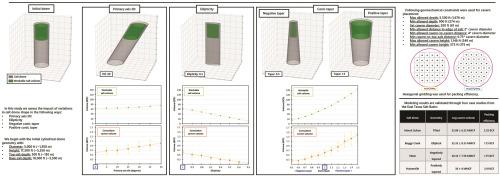Impact of salt dome morphology on geological storage volumetric estimations: Implications for prospect-scale assessment
IF 3.6
引用次数: 0
Abstract
Geological storage in salt caverns plays a critical role in managing energy resources, yet regional assessments often fall short in accounting for specific salt dome morphological variations that can significantly influence cavern engineering and storage capacity. To address this gap, we developed a refined approach to modeling salt domes, incorporating primary axis tilt, ellipticity, and conic taper. These geometric modifications are applied to a cylindrical baseline salt dome model to assess the effects on total salt volume, workable salt volume, and cavern storage potential. Case studies of four salt domes from the East Texas Salt Basin—Mount Sylvan, Boggy Creek, Steen, and Hainesville—validate the observed trends from the models. Our findings reveal that positive cone taper and primary axis tilt configurations enhance storage potential, leading to significant increases in potential cavern volume, while ellipticity and negative cone taper result in reduced storage capacities. The study underscores the importance of refining volumetric assessments by accounting for detailed morphologic variations, providing a more accurate framework for site-specific geological storage evaluations. Additionally, we discuss challenges related to intra-salt heterogeneities, including intra-salt deformation and mineralogical impurities, highlighting the need for improved site characterization to optimize the safety and efficiency of subsurface storage systems. This work contributes to the development of scalable and reliable geological storage infrastructure, essential for meeting future energy demands.

盐丘形态对地质储层体积估算的影响:对远景规模评估的影响
盐洞的地质储存在能源管理中起着至关重要的作用,但区域评估往往无法考虑到具体的盐丘形态变化,而这些变化会对盐洞工程和储存能力产生重大影响。为了解决这一差距,我们开发了一种精细的方法来模拟盐丘,包括主轴倾斜、椭圆性和圆锥锥度。这些几何变化应用于圆柱形基线盐丘模型,以评估对总盐体积、有效盐体积和洞穴储存潜力的影响。对东德克萨斯盐盆地的四个盐丘(mount Sylvan、Boggy Creek、Steen和hainesville)的案例研究证实了模型中观察到的趋势。研究结果表明,正锥度和主轴倾斜结构增加了潜在的储藏量,导致潜在的洞室体积显著增加,而椭圆和负锥度结构导致储藏量减少。该研究强调了通过考虑详细的形态变化来改进体积评估的重要性,为特定地点的地质储存评估提供了更准确的框架。此外,我们还讨论了与盐内非均质性相关的挑战,包括盐内变形和矿物杂质,强调了改进场地表征以优化地下储存系统的安全性和效率的必要性。这项工作有助于开发可扩展和可靠的地质存储基础设施,这对于满足未来的能源需求至关重要。
本文章由计算机程序翻译,如有差异,请以英文原文为准。
求助全文
约1分钟内获得全文
求助全文

 求助内容:
求助内容: 应助结果提醒方式:
应助结果提醒方式:


